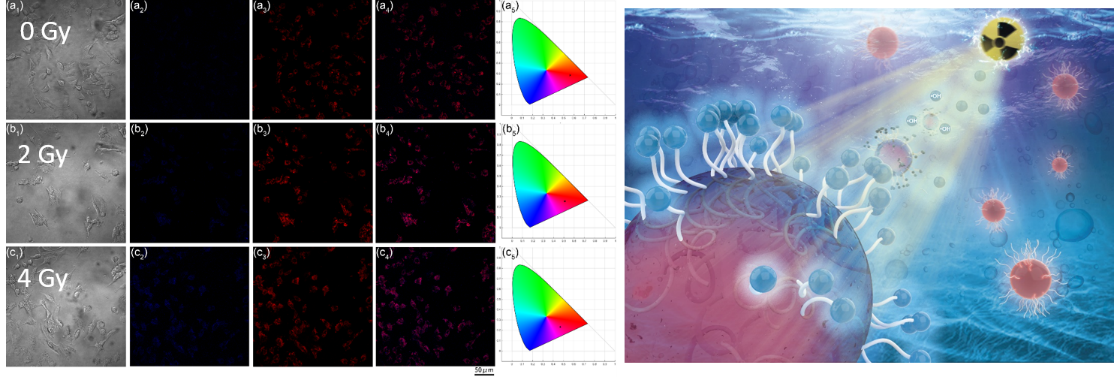

Highlights
To overcome the drawbacks of current dosimeters (e.g., poor tissue-equivalence, time-consuming, complex manipulation and/or costly), Prof. Liang Hu group designed a nano-sized PAAm hydrogel particle (or PAAm nanogel) sensor for colorimetric fluorescent measurement of IR dose (using X-rays as a model). The PAAm-based nanogel sensor is composed of coumarin-3-carboxylic acid (CCA, as an IR sensitive fluorescent probe) and 5(6)-carboxytetramethylrhodamine (TAMRA, as an IR inert probe). When exposed to IR, the C7 position of CCA molecule reacts with hydroxyl radicals (·OH) from water radiolysis and, thus, transitions to 7-hydroxyl-coumarin-3-carboxylic acid (7-OH-CCA), emitting a strong blue fluorescence (λem=450 nm)) under UV excitation (λex=400 nm).14-17 By contrast, TAMRA molecule emits relatively stable red fluorescence (λem=580 nm)) under UV irradiation (λex=530 nm) regardless of IR exposure. Coupled with dual fluorescent probes, our nanogels exhibited colorimetric fluorescent as a function of varying IR dose. Therefore, the nanogels were capable of measuring IR dose in a clinical level, visually and spectrally. Furthermore, our colorimetric fluorescent nanogel sensor was able to measure intracellular IR dose, indicating a potential in investigating the radiobiology effects of tumor cellular and, in turn, improve the efficiency of radiotherapy. Their work has been published in Chemical Communications (Chem. Commun., 2019, 55, 9614--9617), titled as “A nanogel sensor for colorimetric fluorescence measurement of ionizing radiation doses”.

Link to Paper:https://pubs.rsc.org/en/content/articlelanding/2019/cc/c9cc03680f/unauth#!divAbstract
Link to Prof. Hu’s group:http://fyxy.suda.edu.cn/mrtc/